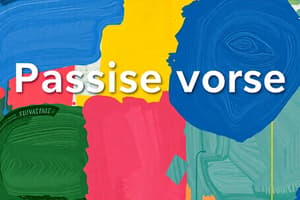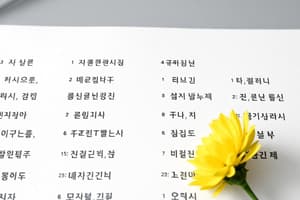Podcast
Questions and Answers
In the context of clarifying a situation, which of the following best describes the function of the Korean grammar pattern '~는/(으)ㄴ 거예요'?
In the context of clarifying a situation, which of the following best describes the function of the Korean grammar pattern '~는/(으)ㄴ 거예요'?
- To explain or clarify the reason or background of a situation. (correct)
- To emphasize a contrast between two actions.
- To express a future intention or plan.
- To make a suggestion or offer to someone.
When someone says '면도하다가 다친 거예요' after having cut their face, what are they trying to convey?
When someone says '면도하다가 다친 거예요' after having cut their face, what are they trying to convey?
- They are explaining how they got the cut while shaving. (correct)
- They are predicting future shaving accidents.
- They are seeking sympathy for their injury.
- They are complaining about the quality of their razor.
If someone asks '지금 뭐 먹는 거예요?' while seeing another person eating something, what is the most likely intention?
If someone asks '지금 뭐 먹는 거예요?' while seeing another person eating something, what is the most likely intention?
- To warn the person about the food's ingredients.
- To inquire about what the person is currently eating. (correct)
- To request a bite of the food.
- To criticize the person's food choice.
In the sentence, '파마 전문 미용실에서 한 거예요,' what does it imply about the speaker's hairstyle?
In the sentence, '파마 전문 미용실에서 한 거예요,' what does it imply about the speaker's hairstyle?
If someone says '영화배우 구경하는 거예요' in response to the question '사람들이 왜 저렇게 모여 있어요?', what does it reveal about the crowd's behavior?
If someone says '영화배우 구경하는 거예요' in response to the question '사람들이 왜 저렇게 모여 있어요?', what does it reveal about the crowd's behavior?
When someone states '제가 만든 거예요' in response to the question '이 케이크 민지 씨가 가져왔어요?', what information are they conveying?
When someone states '제가 만든 거예요' in response to the question '이 케이크 민지 씨가 가져왔어요?', what information are they conveying?
In the context of tipping in the US, if someone says '보통 10 퍼센트 이상 주는 거예요,' what are they indicating?
In the context of tipping in the US, if someone says '보통 10 퍼센트 이상 주는 거예요,' what are they indicating?
What does the phrase '갈비를 태웠어요' imply about the speaker's cooking experience?
What does the phrase '갈비를 태웠어요' imply about the speaker's cooking experience?
In the dialogue about the crying baby, what is implied by the statement '우유를 4시에 먹이고 안 먹였거든요'?
In the dialogue about the crying baby, what is implied by the statement '우유를 4시에 먹이고 안 먹였거든요'?
If someone says they had a hard time with the baby because '너무 안 자서 재우느라고 힘들었어요,' what does this imply?
If someone says they had a hard time with the baby because '너무 안 자서 재우느라고 힘들었어요,' what does this imply?
Flashcards
~는(으)ㄴ 거예요/거야
~는(으)ㄴ 거예요/거야
Used to clarify or recount events, meaning 'The fact is...', 'What it is, is...', or 'What happened is...'
~는(으)ㄴ 거예요
~는(으)ㄴ 거예요
Polite style ending for clarifying statements.
~는(으)ㄴ 거야
~는(으)ㄴ 거야
Intimate style ending for clarifying statements.
~는(으)ㄴ 겁니다
~는(으)ㄴ 겁니다
Signup and view all the flashcards
Causative Verbs
Causative Verbs
Signup and view all the flashcards
먹이다
먹이다
Signup and view all the flashcards
웃기다
웃기다
Signup and view all the flashcards
입히다
입히다
Signup and view all the flashcards
깨우다
깨우다
Signup and view all the flashcards
재우다
재우다
Signup and view all the flashcards
Study Notes
- Lesson 9, Conversation 2 is from KORE 2314 Intermediate Korean II, Fall 2016
G9.3: ~는(으)ㄴ 거예요/거야 'The fact is ...'
- This grammar point describes events or states of affairs to clarify or recount them
- It translates to “What it is, is...”, “The fact is ...", or "What happen is ...".
- ~는(으)ㄴ 거예요 is Polite style
- ~는(으)ㄴ 거야 is Intimate style
- ~는(으)ㄴ 겁니다 is Deferential style
Examples of sentence structures:
- 성희: 어, 얼굴을 다쳤네요. Presenting concern about an injury
- 마크: 면도하다가 다친 거예요. Stating the cut was from shaving.
- A: 어, 머리 예쁘다! Complimenting new hair
- B: 지난 달에 한국 갔을 때 파마한 거야. Saying they got it permed last month when they visited Korea.
- A: 시험 공부하세요? Asking if person is studying
- B: 아니요. 그냥 책 읽는 거예요. Responding that they are only reading.
- A: 지금 뭐 먹는 거예요? - Asking what the person is eating when they are observed eating something strange
G9.3 Exercise ~는/(으)ㄴ 거예요 clarifying situations provided:
- A: 머리 너무 예쁘네요. Compliment stating very pretty hair
- B: 파마 전문 미용실에서 한 거예요. Saying the perm came from a professional salon.
- A: 와, 예쁘다! stating pretty and inquiring where the article of clothing was purchased
- B: 명품 매장에서 산 거예요. Saying it was bought at brand-name store
- A: 사람들이 왜 저렇게 모여 있어요? Asking why people are grouped together
- B: 영화배우 구경하는 거예요. Saying they are gathered to see a celebrity
- 영미: 이 케이크 민지 씨가 가져왔어요? Inquiring about the cake
- 민지: 네, 제가 만든 거예요. Saying they baked the cake
- America: 미국에서는 팁을 얼마 줘요? Inquiring how much to tip in America
- B: 보통 10 퍼센트 이상 주는 거예요. Saying to tip 10 percent or more
G9.4 Exercise Causative verbs
- 마크: 요리 솜씨가 많이 늘었어요? Complimenting someone's cooking skills
- 동수: 아니요, 어제는 갈비를 태웠어요. Disagreeing and stating they burnt the ribs yesterday
- A: 아기가 울어요. - Stating the baby is crying
- B: 배고파서 그래요. They must be hungry.
- 우유를 4시에 먹이고 안 먹었거든요. Meaning they ate milk, and not ate food.
- A: 아기 울리지 말고 빨리 우유를 주세요. Don't let the baby cry, quickly give the baby the milk
- 아기 오래 울면 안 좋아요. - It's not good to let the baby cry for a long time
- A: 아기가 자요? Questioning of baby is asleep
- B: 네, 겨우 잠 들었어요. - Response yes, the baby barely went to sleep.
- 너무 안 자서 재우느라고 힘들었어요. Because the baby wouldn't sleep, putting it to sleep was difficult.
- A: 아기 옷 다 입혔어요? Asking about the baby's clothes
- B: 아니요, 아직요. 아기가 울어서요. Affirming that the baby is unsettled. Baby has not been dressed yet.
- A: 아기가 왜 안 웃어요? - Asking why baby is grim
- B: 글쎄요. 졸린가 봐요. 한번 웃겨 보세요. Hmm, maybe they are sleepy. Try to make them laugh.
- 엄마: 형 일어났니? Mom asking if sibling is awake
- 폴: 아니요, 아직 자고 있는데요. Paul responding with the information the sibling is asleep
- 엄마: 빨리 가서 깨워. 학교 늦었어. Mom directs, quickly go wake your sibling, they are late to school.
Studying That Suits You
Use AI to generate personalized quizzes and flashcards to suit your learning preferences.




